Cincinnati State has made its share of headlines over the years. The College Archives has quite an extensive collection of newspaper and magazine articles about the college in our collection. Below is a sampling of some of these stories (and some photos for illustration) to help us celebrate 45 years since the college’s founding in 1969.
1960s

n.d. – When the college first opened, it shared space with Courter Technical High School (the former Central High School. Cincinnati Technical Institute purchased the property from the Cincinnati Board of Education for $8.4 million in 1970.

Cincinnati Enquirer, 1966 – By the middle of the 1960s, Cincinnati school officials recognized the need for a technical college in the region. The original proposal limited enrollment to 200 students, allowing a maximum of 50 students to enroll in each of four areas of technology: business data processing, graphic communication technology, sales and marketing technology, and technical drafting. From the very beginning, providing students with invaluable co-op experience was at the core of the college’s mission, with a proposed 10 weeks of study followed by 10 weeks of co-op.
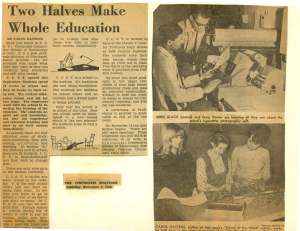
This Cincinnati Enquirer article from Nov. 5, 1966 discusses the unique co-op program at the college which allowed students to spend half of their time at the college in the classroom and the other half working in their chosen field .
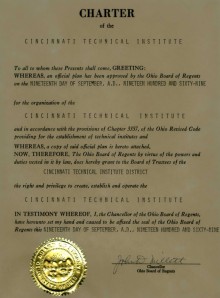
1969 – The college was chartered by the State of Ohio as Cincinnati Technical Institute. Initial enrollment was 651 students.
To learn more about the early beginnings of the school, check out these previous exhibits:
- 40th Anniversary (1969-2009) – History of Cincinnati State (Spring/Fall 2009)
- The College That Works: Over 40 years of Cooperative education at Cincinnati State (Fall 2010)
1970s

Cincinnati Enquirer, 1970 – In January of 1970, Cincinnati Technical Institute announced the development of a master plan. By 1980, CTI envisioned 7 times as many students and 9 times as many programs.

unknown publication, 1970 – Cincinnati Technical Institute’s fifth year saw enrollment at 1,250 students, nearly tripling in 3 years. In addition to an increase in enrollment, 1970 saw an increase in programs, staff, and employers participating in the co-op program. This trend would continue throughout the decade.
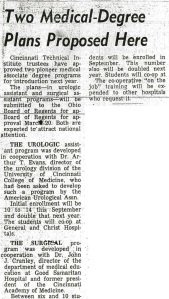
Cincinnati Post, 1970 – Two of the first programs added after the unveiling of Cincinnati Technical Institute’s master plan were also pioneer medical associate programs. The degrees—in urologic assistant and surgical assistant programs—were expected to attract national attention.

1973 – Students standing outside of the auditorium. By 1977, Cincinnati Technical College enrolled 3,700 (12.5% increase) while other area colleges saw a decrease in enrollment.

ca 1976 – The original campus library was on the second floor of the main building, where the Writing Center lab is now located. By the mid-1970s, increased enrollment necessitated a larger library, and construction began to convert the Courter Tech auditorium into the Library Resources Center.
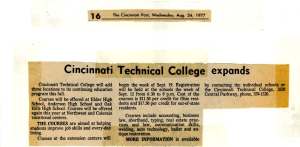
Cincinnati Post, 1977 – CTC extended its reach into the community by offering continuing education programs at area high schools. Courses included (but are not limited to) accounting, real estate law, and antique restoration.

Cincinnati Enquirer, 1978 – In keeping with its master plan, Cincinnati Technical College added many programs, including an associate degree in laser optics and in scientific measurement and management.
1980s
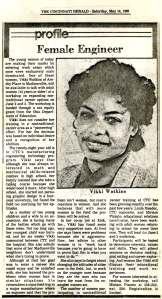
Cincinnati Herald, 1983 – In an effort to encourage women to enter work areas traditionally dominated by men, CTC counselor Linda Meador and educational relations coordinator Miriam Pizzuto created a workshop to promote the exploration of non-traditional career options. The speakers and guests included women in nontraditional fields, including Vikki Watkins, a student in CTC’s manufacturing and engineering technology program.

Downtowner Newspaper, 1983 – Later that year, CTC hosted another workshop called “Expanding Non-Traditional Career Options for Women.” At this workshop, represented occupations included personnel managers, computer programmers, production coordinators, mechanical designers, architects, horticulturists, physicians, and accountants.
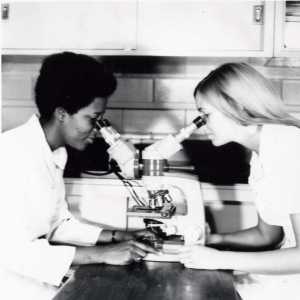
n.d. – Women are often not given the proper encouragement to study science and/or technology programs. In this undated picture, two female students look at specimens under a microscope.

Western Hills Press, 1987 – Several years later, CTC expanded its reach and hosted a 3-week workshop called “Up, Up and Away for Non-traditional Careers for Young Women,” aimed at high school girls. The goal of the workshop was to “show girls in school that there are good reasons to stay in math and science courses.”

1984 – In the mid-1980s, Cincinnati State began hosting workshops to encourage women to pursue studies in STEM (Science, Technology, Engineering, and Mathematics) fields. This 1984 photo shows Pam Maher, one of 3 women enrolled in the electrical engineering program.
1990s

Cincinnati Post, 1993 – In the summer of 1993, Cincinnati Technical College’s Board of Trustees authorized President Long to petition the Ohio Board of Regents permission to convert to a community college. The conversion would mean both a new name and that, for the first time, credits earned could be transferred to four-year program.

1994 – With the name change from Cincinnati Technical College to Cincinnati State Technical and Community College came new signs. But more than just a longer moniker, the conversion to community college status allowed the college to offer courses with transferable credits as well as associate of arts and associate of science degrees.

Cincinnati Enquirer, 1994 – On September 1, 1994, the college transitioned from Cincinnati Technical College to Cincinnati State Technical and Community College, Cincinnati State for short. But this was more than just a name change: for the first time, the college would offer associate of arts degrees and associate of science degrees, with credits that would count toward a bachelor degree. Despite the transition, the commitment to providing nationally recognized technical programs and a major co-op program is still intrinsic to Cincinnati State’s values.

1994 – President Long helps out at the name change picnic. Although there was some hesitation at first, many faculty, students, and staff were excited about the conversion from a technical school to a community college. The change was also estimated to increase enrollment by 10% in the first year, within an additional 1,600 students within three years.
2000s

2002 – In the summer of 2002, Cincinnati State held a groundbreaking ceremony for the new Advanced Technology and Learning Center (ATLC). Slated to open in 2004, the $55 million center would add 12 kitchens for the culinary arts program, a 200-seat auditorium, computer labs, a cafeteria, lounges, and a bookstore.

2004 – This bricklayer’s sketch previews the new courtyard and green space that would accompany the ATLC. Administration hoped that making the buildings and grounds more inviting would encourage students to spend more time on campus outside of class, helping to engender a more “college” feel.

Cincinnati Enquirer, 2005 – In the summer of 2002, construction began on the Advanced Technology and Learning Center. But the new building wasn’t just going to provide extra classroom space: the $55 million center would add 12 kitchens for the culinary arts program, a 200-seat auditorium, a cafeteria, lounges (replete with fireplaces!) and a bookstore. Administrators hoped the new building would create a more welcoming campus—a place where students would want to spend time outside of class. And even before the center became fully operational in the spring of 2005, students were already sharing the sentiment: “It feels more like…college.”

n.d. – The ATLC is inviting both inside—with multiple student lounges replete with fireplaces—and outside—with benches, picnic tables, and even a small outdoor performance space.
2010s

Cincinnati Business Courier, 2011 – In March of 2011, Cincinnati State was awarded a Green Business Award in education/outreach. Since establishing itself as the first Ohio college to be approved for a renewable energy major in 2007, Cincinnati State has proven itself committed to promoting sustainable energy and green living. In addition to offering degrees in such areas as sustainable horticulture, environmental engineering, and storm water management, Cincinnati State is “also trying to model ourselves with the same behavior.”

2011 – Vice President Monica Posey and others pose with the Green Business Award. A runner-up in 2010, Cincinnati State earned the award in 2011 as a result of the college’s efforts to promote green classes and community programs.

Cincinnati Enquirer, 2010 – In the fall of 2010, Cincinnati State and the Metropolitan Sewer District (MSD) unveiled their plan to build new porous-concrete parking lots in an effort to divert 11 million gallons of rainwater from the MSD. Adjacent to the parking lots, the plan proposed to build special rain garden collection sites. The MSD paid for over two-thirds of the project, which was considered a test to see if similar interventions could work in other places.

2012 – Although preparation was several years in the making, the rain garden near the Ludlow parking garage was installed in early 2012. As part of the storm water management project funded by the Metropolitan Sewer District, the gardens help to reduce rain water runoff, and is just one of many environmentally sustainable or “green” projects at Cincinnati State.





Pingback: New Archives exhibit celebrates the College’s 45th anniversary |
Pingback: Women and Technology circa 1980’s | Women & Tech Project